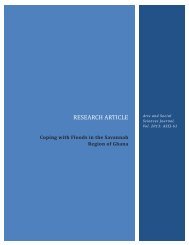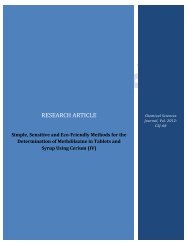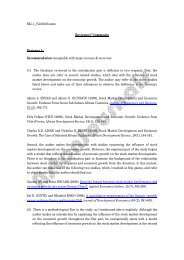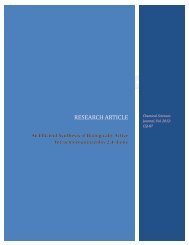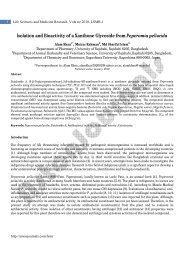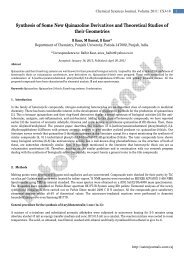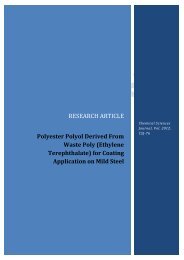Reversed Phase Partition Chromatographic ... - AstonJournals
Reversed Phase Partition Chromatographic ... - AstonJournals
Reversed Phase Partition Chromatographic ... - AstonJournals
Create successful ePaper yourself
Turn your PDF publications into a flip-book with our unique Google optimized e-Paper software.
Chemical Sciences Journal, Vol. 2011: CSJ-273M HClO 4 , and 0.5-3.0 M HBr. However, in our studies we found that HCl, H 2 SO 4, CH 3 COOH were found to be aninefficient eluents for Gd(III). Further the elution study of Gd(III) in this work was carried out with 1.0 M HBr, asshown in Figure 1. We choose 1.0 M HBr for metal ions separation in multicomponent mixtures because it formsstrong bromo- complex. Elution profile of various eluting agents is shown in Figure 2.Percentage Sorption10090807060504030201000 2 4 6 8Concentration of Eluant(M)HCl H2SO4 HClO4 CH3COOH HBrFigure 1: Elution profile of Gd(III) with various eluting agents.100For HClFor H2SO4Percentage Sorption90807060504030201000 5 10 15 20Volume of Eluent mLPercen tag e Sorptio n10090807060504030201000 5 10 15 20Volume of Eluent mL0.1 0.5 1 2 3 40.1 0.5 1 2 3 45 6 7 85 6 7 8Figure 2a: Elution profile of HCl. Figure 2b: Elution profile of H 2 SO 4 .http://astonjournals.com/csj
4 Research ArticlePercen tag e sorption100For HClO490807060504030201000 5 10 15 20Volume of Eluent mL0.1 0.5 1 2 3 45 6 7 8Figure 2c: Elution profile of HClO 4 .Percen tag e S o rp tio nFor CH3COOH10090807060504030201000 5 10 15 20Volum e of Eluent m L0.1 0.5 1 2 3 45 6 7 8Figure 2d: Elution profile of CH 3 COOH.For HBrPercentage Elution10090807060504030201000 5 10 15 20Volum e of Eluent mL0.1 0.5 1 2 3 45 6 7 8Figure 2e: Elution profile of HBr.3.3. Breakthrough capacity of poly[dibenzo-18-crown-6]The breakthrough capacity for Gd(III) was carried out on 1.0 g of poly[dibenzo-18-crown-6] with 1×10 -4 M hippuricacid. The volume of Gd(III) sample solution employed was 10.0 mL. The concentration of Gd(III) was varied from100 to 800 µg of Gd (III)/10.0 mL solution. After sorption, the elution of Gd(III) was carried out with 1.0 M HBr at aflow rate of 0.5 ml/ min. From the results shown in Figure 3, it is clear that the sorption of Gd(III) was quantitativeup to 450 µg/10 mL. The extent of sorption of Gd(III) is decreased with increase in concentration of Gd(III). Fromthe study it was found that the breakthrough capacity of poly[dibenzo-18-crown-6] for Gd(III) was found to be0.572±0.01 mmol/g of crown polymer.http://astonjournals.com/csj
Chemical Sciences Journal, Vol. 2011: CSJ-275100Percentage sorption8060402000 200 400 600 800 1000Concentration of Gd(III)Figure 3: Effect of varying concentration of Gd(III).3.4. Diverse ion effectThe effect of foreign ions on the sorption of Gd(III) was investigated by adding known amount of foreign ion to astandard Gd(III) solution and by comparing the final absorbance with standard. An aliquot of solution containing100 µg of Gd(III) was mixed with foreign ions and hippuric acid was added so that its concentration was 1×10 -4 M intotal volume of 10 mL. The tolerance limit of other ions which do not cause a deviation of more than 2% in theabsorbance in determination of Gd(III) is given in table 2. The column was equilibrated with 1×10 -4 M hippuric acidand binary mixture solution was passed through a poly[dibenzo- 18-crown-6] column at flow rate of 0.5 mL/min.Various foreign ions were not sorbed and hence passed through the column. The results show that most commonions do not interfere with the determination. The effluent was collected and analyzed for foreign ion content.Zn(II), Cd(II), Ni(II) and Th(IV) were sorbed quantitatively and there separation is carried out in our subsequentstudy employing multicomponent mixtures.IonLi +Na +K +Rb +Cs ++NH 4Be 2+Ca 2+Sr 2+Ba 2+Co 2+Ni 2+Mn 2+Zn 2+Cd 2+Pb 2+Cr 3+Fe 3+Cu 2+Table 2: Separation of Gd (III) from binary mixtures.Gd(III) - 100 µg, sorption - 1×10 -4 M hippuric acid, eluent - 1.0 M HBrTol. LimitAdded as(mg) Ion Added asLiCl4Al 3+Al 2 (SO 4 ) 3 .16H 2 ONaCl8Zr 4+Zr(NO 3 ) 4 .4H 2 OKCl3La 3+La(NO 3 ) 3RbCl1Ce 3+CeCl 2 .6H 2 OCsCl3V 4+VOSO 4 .4H 2 ONH 4 Cl2Th 4+Th(NO 3 ) 4BeSO 4 .4H 2 O0.5W 6+Na 2 WO 4 .4H 2 OCaCl 20.1U 6+UO 2 (NO 3 ) 2 .6H 2 OSr(NO 3 ) 20.2Cl -HClBa(NO 3 ) 20.8Br -HBrCoCl 2 .6H 2 O1SCN -NaSCNNiCl 2 .6H 2 O0.5-ClO 4 HClO 4MnCl 2. 4H 2 O2CH 3 COO -CH 3 COOHZnCl 222-SO 4 H 2 SO 4(CH 3 COO) 2 Cd.H 2 O5TartrateTartaric acidPb(NO 3 ) 21EDTAEDTACr(NO 3 ) 3 .9H 2 O0.5 AscorbateAscorbic acidFeCl 3 .6H 2 O0.5CitrateCitric acidCuCl 22Tol. Limit(mg)10.50.5120.530.2224430.6310126http://astonjournals.com/csj
6 Research Article3.5. Sequential separation of Gd(III) from other elements (multicomponent mixtures)The mixture of Sr(II), Mg(II), Ca(II), Zn(II), Ni(II), Cd(II),Th(IV) and Gd(III) was mixed with 1×10 -4 M hippuric acid in atotal volume of 10ml. Sr(II)/ Mg(II)/Ca(II) were not sorbed and passed through column. Zn(II), Ni(II), Cd(II) andTh(IV) sorbed on the column along with Gd(III). Th(IV) was eluted with 0.2 M ammonium oxalate at this conditionZn(II)/ Ni(II)/ Cd(II) and Gd(III) were not eluted and remained on the column. Then Zn(II)/ Ni(II)/ Cd(II) eluted with0.5 M CH 3 COOH and the remaining Gd(III) on the column was eluted with 1.0 M HBr and determined by standardmethods [15,16] as shown in table 3 and chromatograms of all metal ions shown in Figure 4.Table 3: Separation of Gd(III) from other elements (multicomponent mixtures).MixtureSr(II)Th(IV)Zn(II)Gd(III)Ca(II)Th(IV)Ni(II)Gd(III)Mg (II)Th(IV)Cd(II)Gd (III)Mg(II)Th(IV)Ni(II)Gd(III)Sr(II)Th(IV)Ni(II)Gd(III)Ca(II)Th(IV)Zn(II)Gd(III)Takenµg505050505050505050505050505050505050505050505050Recovery*%98.1698.7897.8398.9499.0197.8698.12100.0099.0199.2198.6098.1098.4198.1297.51100.0099.1198.6197.5699.31100.0098.1197.9299.12SD±0.25±0.07±0.01±0.01±0.06±0.37±0.10±0.01±0.20±0.94±0.26±0.06±0.41±0.10±0.11±0.06±0.05±0.50±0.03±0.12-±0.64±0.65±0.06EluentNSPC**0.2 M A.O.0.5 M CH 3 COOH1.0 M HBrNSPC0.2 M A.O.0.5 M CH 3 COOH.1.0 M HBrNSPC0.2 M A.O.0.5 M CH 3 COOH1.0 M HBrNSPC0.2 M A.O.0.5 M CH 3 COOH1.0 M HBrNSPC0.2 M A.O.0.5 M CH 3 COOH1.0 M HBrNSPC0.2 M A.O.0.5 M CH 3 COOH1.0 M HBr*Average of triplicate analysis**NSPC - No Sorption Passing through the ColumnA.O. - Ammonium oxalatehttp://astonjournals.com/csj
Chemical Sciences Journal, Vol. 2011: CSJ-277Figure 4a: Separation of Sr(II), Th(IV), Zn(II), Gd(III).Figure 4b: Separation of Ca(II), Th(IV), Ni(II), Gd(III).http://astonjournals.com/csj
8 Research ArticleFigure 4c: Separation of Mg(II), Th(IV), Cd(II), Gd(III).Figure 4d: Separation of Mg(II), Th(IV), Ni(II), Gd(III).http://astonjournals.com/csj
Chemical Sciences Journal, Vol. 2011: CSJ-279Figure 4e: Separation of Sr(II), Th(IV), Ni(II), Gd(III).Figure 4f: Separation of Ca(II), Th(IV), Zn(II), Gd(III).Figure 4 (a-f): Chromatograms of multicomponent mixture separation.http://astonjournals.com/csj
10 Research Article3.6. Reproducibility of methodReproducibility of the method was checked by thirty replicate analysis of a standard Gd(III) solution. The resultsindicate the method to be fairly reproducible. The poly[dibenzo-18-crown-6] could be recycled many times withoutaffecting its sorption capacity. The reusability of poly[dibenzo-18-crown-6] with standard deviations is shown intable 4.Table 4: Reproducibility of method.S. No. Gd(III) 100 µg Recovery (%) S.D.1 100 99.86 ±0.062 100 99.60 ±0.073 100 99.32 ±0.384 100 98.90 ±0.615 100 99.96 ±0.336 100 98.96 ±0.057 100 99.70 ±0.278 100 99.61 ±0.119 100 99.39 ±0.0510 100 99.73 ±0.1711 100 98.60 ±0.7912 100 99.86 ±0.4313 100 99.81 ±0.3614 100 99.62 ±0.2115 100 100 ±0.0916 100 99.71 ±0.7617 100 100 ±0.5118 100 99.16 ±0.0119 100 98.86 ±0.2020 100 99.61 ±0.1721 100 99.52 ±0.4322 100 98.9 ±0.1723 100 99.16 ±0.0224 100 99.9 ±0.0125 100 100 ±0.0126 100 100 ±0.2127 100 99.66 ±0.6628 100 99.89 ±0.0829 100 99.98 ±0.4130 100 99.56 ±0.013.7. Determination of Gd(III) from real samples (composite materials)The composite material samples after acid treatment are subjected to proposed method for the determination ofGd(III). The percentage of Gd(III) found after triplicate analysis is shown in table 5.http://astonjournals.com/csj
Chemical Sciences Journal, Vol. 2011: CSJ-2711Table 5: Determination of Gd(III) from real sample.SamplePercentage of Gd(III)Certified valueProposed methodGdSrO 2 10.0 % 9.88 % ( ±0.21)4. ConclusionProposed method is simple, rapid, highly selective and easily reproducible for the separation and determination ofGd(III). Low reagent and acid concentration are required for quantitative recovery of Gd(III). The poly[dibenzo-18-crown-6] could be recycled many times without affecting its sorption capacity i.e. it has higher stability as astationary phase. It permits the separation of Gd(III) from other elements. Precision in terms of the standarddeviation of the present method are very retainable for the determination of Gd(III).Competing InterestsWe have no competing interests.Authors’ ContributionsBSM, SRS, KRM made the plan, explained data. KRM dissected the results involved in the preparation ofmanuscript, carried out experimental work. NSM, GHN provided literature survey.References[1] Maestro P, Huguenin D, 1995. Industrial applications of rare earths: which way for the end of the century.Journal of Alloys and Compounds, 255: 520-528.[2]Will J, Mitterdorfer A, Kleinlogel C, et al., 2000. Fabrication of thin electrolytes for second-generation solid oxidefuel cells. Solid State Ionics, 131: 79-96.[3] Gupta KK, Manchanda VK, Subramanian MS, et al., 2000. Solvent extraction studies on U(VI), Pu(IV) and fissionproducts using N,Ndihexyloctanamide. Solvent Extraction and Ion Exchange, 1: 273–292.[4] Lawrosky S, 1955. Survey of separation processes other than solvent extraction. Chemical Engineering Progress,51: 461.[5] Grebenschikova VI, Bryzgalova RV, 1960. A study of the co-precipitation of Pu(IV) with lanthanum oxalate.Radiokhimia, 2: 265–273.[6] Korkish J, 1989. Handbook of Ion Exchange Resins: Their Application to Inorganic Analytical Chemistry, vol. II,CRC Press, Inc.[7] Pedersen CJ, 1967. Cyclic polyethers and their complexes with metal salts. Journal of American ChemicalSociety, 89 (26): 7017-7036.[8] Christensen JJ, Eatough DJ, Izatt RM, 1974. The synthesis and ion binding of synthetic multidentate macrocycliccompounds. Chemical Reviews, 74 (3): 351.http://astonjournals.com/csj
12 Research Article[9] Izatt RM, Bradshaw JS, Nielsen SA, et al., 1985. Thermodynamic and kinetic data for cation-macrocycleinteraction. Chemical Reviews, 85 (4): 271-339.[10] Izatt RM, Pawlak K, Bradshaw JS, et al., 1991. Thermodynamic and kinetic data for macrocycle interaction withcations and anions. Chemical Reviews, 91 (8): 1721-2085.[11] Sachleben RA, Deng Y, Bailey DR, et al., 1996. Ring-size and substituent effects in the solvent extraction ofalkali metal nitrates by crown ethers in 1,2dichloroethane and 1-octanol. Solvent Extraction and Ion Exchange, 14(6): 995-1015[12] Sabale SR, Mohite BS, 2010. <strong>Chromatographic</strong> separation of uranium(VI) from other elements using L-valineand poly[dibenzo-18-crown-6]. Journal of Analytical Chemistry, 65 (8): 809-813.[13] Sabale SR, Jadhav DV, Mohite BS, 2009. Lanthanum(III) sorption studies on poly[dibenzo-18-crown-6] and itsseparation from uranium(VI) and thorium(IV) in L-valine medium. Journal of Rare Earths, 27 (5): 825-829.[14] Sabale SR, Jadhav DV, Mohite BS, 2010. Sorption study of U(VI), Th(IV) and Ce(III) on poly[dibenzo-18-crown-6]in L-arginine to develop sequential column chromatographic separation method. Journal of Radioanalytical andNuclear Chemistry, 284: 273–278.[15] Marczenko Z, 1976. Spectrophotometer Determination of Elements. Chichester, Ellis Horword Limited.[16] Vogel AI, 1975. A Textbook of Quantitative Inorganic Analysis, 3 rd Ed, London, Longmans.[17] Savvin SB, 1974. Organic reagents of the arsenazoIII group. Moscow, Atomizctat.http://astonjournals.com/csj


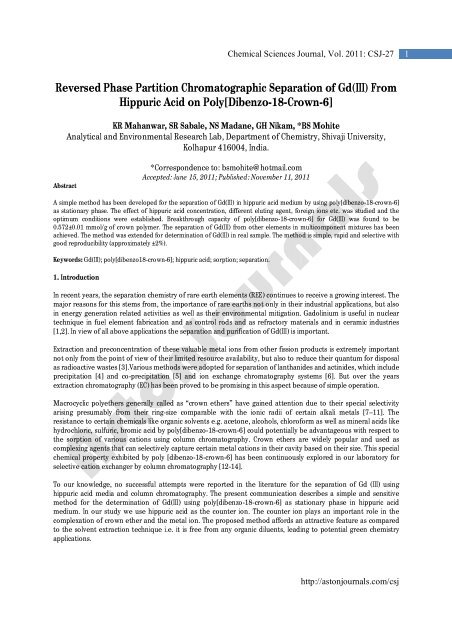
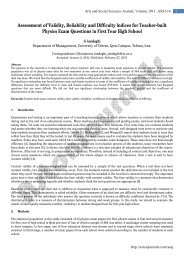
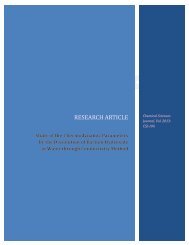
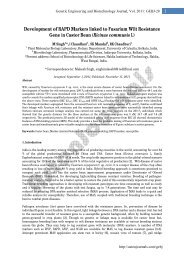

![[1,4]-benzodiazepine-2-one Derivatives as Potent - AstonJournals](https://img.yumpu.com/49117784/1/184x260/14-benzodiazepine-2-one-derivatives-as-potent-astonjournals.jpg?quality=85)
